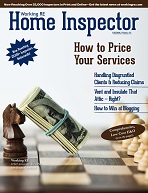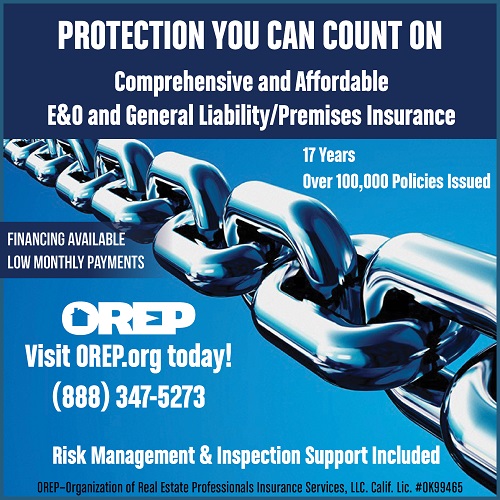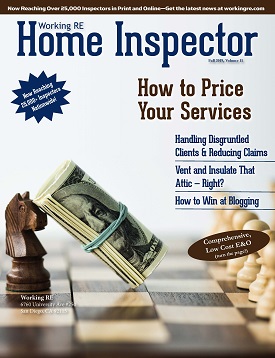 |
> E&O/GL Insurance for Home Inspectors Competitive Rates, Broad Coverage, Free Risk Management, online inspection support for tough questions, discounts on education and more… Professional Coverage, Competitive Pricing Shop OREP today! |
How to Price Your Services
by Ian Robertson, Inspector ToolBelt
As home inspectors, we are in business because we love what we do. But we also need to make a living. We should not simply “get by,” we should thrive. We have a lifetime of knowledge and information that is sorely lacking in modern society, and very much needed—especially by those buying or selling a home.
Our profession can’t be outsourced to another country and the vast majority of people won’t buy a home without us. But with our profession so needed, pricing our services is still one of the hardest things for a home inspector to do, especially if we are new to the industry. Sometimes we feel that we need to compete on price to start—and stay—in business. So how can we properly price our services? In this article we are going to discuss four topics:
• The cost of doing business
• The pitfalls of charging too little
• How to determine your inspection fee
• How to charge more and MAKE more
• Average Home Inspection Fee
Cost of Doing Business
I was young when I started my first home inspection company: before marriage, before kids and starting fresh. I had grown up surveying and contracting with my family, so home inspections fit right in. I remember doing one of my first inspections and the agent telling me I was “cheap.” I recoiled at this. I had done my research, saw what my competitors were charging and based my fee on that. But in the end, she was right—I was too cheap.
The cost of doing business, especially to new inspectors as I learned, creeps up in ways that may not be expected. As we grew, took on other inspectors and branched out, the expenses grew even more. What are some of those expenses? Some are obvious: gas, truck, inspection software, etc. Some inspectors may say, “what else do you need?”
You can go barebones and use a clipboard and a pen to write your reports, only accept checks to avoid credit card fees and wear unlettered T-shirts, but that won’t help you grow a business. To run a business properly, there is going to be overhead and the more you grow, the more your overhead grows. So let’s do some quick math. Let’s say you want to make $100,000 gross in your inspection business annually. Use the chart below to see how many inspections you would need to do (See Figure 1).

Figure 1
Now let’s analyze this even further. Let’s say you are charging about the national average of $300–$350 per inspection (way too low—the national average today is about the same as it was 30 years ago, which means we are making less per inspection now because of inflation). So at $325 per inspection, you would need to perform about 307 inspections to gross $100,000 dollars. Sounds easy, right? After all, that is only two inspections a day, three days a week. But that’s before expenses.
For instance, according to a 2017 study by the Automobile Association of America, the average vehicle costs about $9,000 per year to operate (gas, repairs, maintenance, etc.). As an inspector, you will beat your vehicle up quite a bit, so let’s increase that number slightly and say $10,000 per year total.
Then you have inspection software. Let’s say $50 per month (depending on if you have subscription software or if you buy one outright, just average the cost over two years). Then you will have a website, hosting, email service, scheduling software and other office items (again, you can do paper, clipboard, and a calendar hanging on your wall—but that is no way to run a business).
Let’s say that is all on the very cheap end of $200 per month. Then you have marketing costs. If you do two real estate office visits where you bring food each month, that is $50. Need cards, logo shirt, promotional items, trade show display items, etc? Then that is even more. On a low-end budget, let’s say your advertising cost is $500 per month.
Then there is home inspection insurance (E&O/GL), legal fees if something comes up, association dues, and a million other things. There will be expenses that you don’t even expect. All in all, you will likely spend about $25,000 to stay in business. So really you only net $75,000—and the government takes about $15,000 of that. So you hauled butt all year to make $60,000 if you were pinching every business penny possible.
We did a cost calculation of what it costs for us to get out of bed in the morning and inspect if averaged out to every inspection, and we took into account every last expense. It turned out to be about $125 per inspection. If we charged $325 per inspection, we would only make $200 per inspection. So the cost of doing business is important to understand. Many home inspection companies don’t last more than a year because they don’t realize what I’m sharing with you now. Even then, if you don’t start putting more money into your business, you will limp along and never grow. Now that we better understand the cost of doing business, that brings us to our next point—why charging too little hurts you and your company.
Pitfalls of Not Charging Enough
I was on the phone with a home inspector who charges WAY too little for his services. Here are his reasons:
• He worries about not getting enough work (i.e. cheap prices mean more volume).
• He worries no one will hire him if his prices are too high.
• He has startup costs and bills to pay and just needs to get working.
• He is not confident in his abilities.
Have those thoughts ever crossed your mind? Well, they were at the top of his. A lot of inspectors think they need to start off cheap to get things going. Some do it just to undercut their competition and try to “take their market share.” But here are the problems with each of those points:
Not getting enough work: This is working off the assumption that everyone cares about price first. That is simply not true. Yes, there are price shoppers (and we will talk about how to deal with price shoppers in part two) but they aren’t everyone. Cheap prices attract price shoppers, and higher prices attract people who don’t care as much about price but prioritize getting a great inspection. Do a lot of price shoppers call you? If so, you may be attracting them and it may be time to raise your prices or change your marketing approach.
No one will hire you if your prices are too high: To be honest, some people won’t hire you if your prices are too LOW either. For example, I recently I saw a Groupon for half off Lasik surgery… umm, not really something I want to get done cheaply—I will gladly pay full price for something that important. That company will lose clients like me for being too inexpensive. A friend of mine had kittens he wanted to give away free and put them on Craigslist—no one called for a week. He then went back in and charged $5 per kitten—they all went in just a few days. The point is that a cheap price or the word “free” can devalue your service, and make your service look less appealing. In fact, you may get more calls from price shoppers if your prices are too low because that is the clientele a cheap price will attract.
Bills and startup costs: we all have bills but that does not mean you should go cheap. There is an inspector I helped get started. He charged $250 for a home inspection. I charged more than double what he did. I told him to raise his prices but he said “I will lose inspections” and I said “Good!” I did the math for him. At $500 per inspection, he would only need to do half as many to make the same amount as if he charged $250. He would also cut his vehicle, travel, and gas expenses in HALF. So even if he lost half his business (which he didn’t) he would literally make more money and work half as much. Don’t worry about losing inspections, worry about the bottom line. Today he charges $550 and does about 250 inspections a year (he has more time off, more money and less stress).
Not confident: none of us would probably admit that we are not confident in ourselves, but if we are totally and completely confident in our abilities, wouldn’t we charge more? There is an inspector I know who charges some of the highest fees I have ever seen. When asked why he charges so much, he says “I’m worth it.” He is a very busy inspector. People sense his confidence on the phone, on his inspections and everywhere else. The point is to know that your knowledge of a home and how it works is becoming rarer in the world, and a more valuable and desired skill every day. Be confident and people will be more inclined to pay your higher fees.
If you are the “cheap inspector” right out of the gate, you tend to get known for that—and not in a good way. There is a “cheap inspector” who I know who became known for his ridiculously cheap inspections. After his first year, he realized he couldn’t make a living on those prices. The problem was that his entire customer base—both agents and clients—expected that, so he was stuck. Don’t get stuck, start off on the right foot by charging the right price. So how much should you charge? Let’s talk about that.
(story continues below)
How to Determine Inspection Fees
My wife was staring at me funny. I had taken time off work and even turned down clients—why? I was sitting at the table calling and emailing inspectors. But this work was very important because it would make me more money and help me price my services properly in the long run. I was doing a market survey. I called and emailed every home inspector I could find in my service area, gave them the same size inspection with the same exact add-on services and got their prices. I learned so much from it that I did it almost every year after that. Some inspectors put their prices on their website, some who I knew really well just told me and some I would just message and call. I would take the average of all the inspection fees and use that as a starting point for setting my prices.
You don’t have to go that far, but it helps. You can also use the InterNACHI Fee Calculator. You can also use the posted prices on inspector websites, join a local chapter of inspectors and ask around; some agents are happy to share that info to an extent. However you do it, every market is going to be different but don’t choose the low-end price. My motto has always been to take the average number and tack some money onto it.
How to Charge More and Make More
If you are just starting out, or you have been inspecting for many years, there are things we can do to raise our prices, grow our bottom line and have our business in good order. Here are some things we have done to raise our prices over the years:
1. Do it slowly. If you charge $199 for an inspection now, then you don’t have to jump right up to $500 per inspection. You can do it slowly. We found that if we raised our fees $25–$50 every six months, most people never even notice.
2. Time it properly. If it is mid-January and the housing market is crazy slow, then that’s not really the time to raise your prices. Our busiest times are always April/May and October—so that is when we would raise our prices. When you raise your prices when you are busier, no one really complains when they stay that way in the slow season.
3. Don’t apologize or make a big deal about it. Don’t feel bad because you raise your fees. Don’t tell a client the fee and fear they will be unhappy with it. Say it confidently and make them feel great about hiring you for that fee. Also, don’t announce it or send out an apology email to agents that refer you—that just draws attention to it.
4. Add value. Add more value to your inspections to show you are worth it. Every time we add value, we raise our prices. When we started using infrared, we raised our prices. When we got a series of new certifications, we raised our prices. Provide more than just a “standard inspection” and people will pay you above-standard fees. (Editor’s Note: E&O coverage from OREP includes most extra add-on services at no additional fee. Please ask your OREP agent for details or ask your agent if not OREP.)
5. Add services. Make every inspection count. You already have your overhead for being there, so add additional services to your arsenal. Offer sewer scopes, radon testing, pest inspections, pool inspections, and anything else that may be valuable to your client. When we added septic inspections to our services, we ended up getting a lot of people who wanted us because they could bundle everything together. We loved it because we were already on site, we gave them an awesome inspection, and they were thrilled—and we were too. Adding services helps the bottom line, and increases overall inspection volume. Always give your client the best services. Don’t give anything sub-par just to add a service on. Make sure you always have the proper training and equipment.
6. Be the best. Easier said than done, right? But it pays to work hard to be the most knowledgeable and capable inspector in town. You will have a fan club of clients who love you because you take care of them. You will attract the right kind of agents who refer you—agents who want you because you really take care of your clients. Always work hard to be the best in your market.
7. Don’t go overboard. Don’t start throwing out big prices just because you want to charge more. That is why I encourage inspectors to find out what others are charging and only go over the average a bit. After that, slow and incremental increases are usually best.
Bottom Line
The lead inspector for one of my inspection companies was worried about raising our prices because he thought we would lose work. We raised them anyway, and work actually increased. Why is that? Because people saw more value in our service. We were also in a different range of clients. The clients we were marketing to cared less about price and more about who we are, what we do and getting a good inspection. We received fewer price shoppers and got busier every time we raised our prices.
The scourge of the home inspection business is low prices. But people would not be able to properly buy homes without us. We have years of experience, training, and knowledge that the average consumer truly needs and we can’t be outsourced or replaced—so why wouldn’t we charge more?
Free Risk Management Online Course Claims and Complaints: How to Stay Out of Trouble
Available Now
Presenter: David Brauner, Senior Insurance Broker OREP
David Brauner, Senior Broker at OREP, shares insights and advice gained over 25+ years of providing E&O insurance for inspectors, showing you how to protect yourself and your business. Watch Now!
About the Author
Ian Robertson is a veteran home inspector, owner of three inspection companies, owner of Full View Home Inspector Marketing, and one of the founders of Inspector Toolbelt. Inspector Toolbelt is simple administrative and scheduling software for home inspectors that makes running your inspection business easy and automated.
Note: The Fall 2019 issue of Working RE Inspector is mailing now to over 25,000 home inspectors nationwide. OREP Insureds enjoy guaranteed delivery of each print magazine and many more benefits.




by ROBERT ROBINSON
We done exactly as stated above and had no issues. Our company does Home, Radon, Termite, Sewer scope, Mold inspections and are considering thermal.
-We also price by Sq. Ft. To keep 5he very small home more affordable.
by Anthony Thomas
Good article with great advice for new start up inspectors. Thanks!
-by Paul Lesieur
Good read. Accurate and simple to understand. Nice work Ian!
-by Town and Country
Very good article…
-by Ian Robertson
Thank you for the opportunity to contribute this article!
-by Brian
“How To Price Your Services” very nice article. Thank you
-